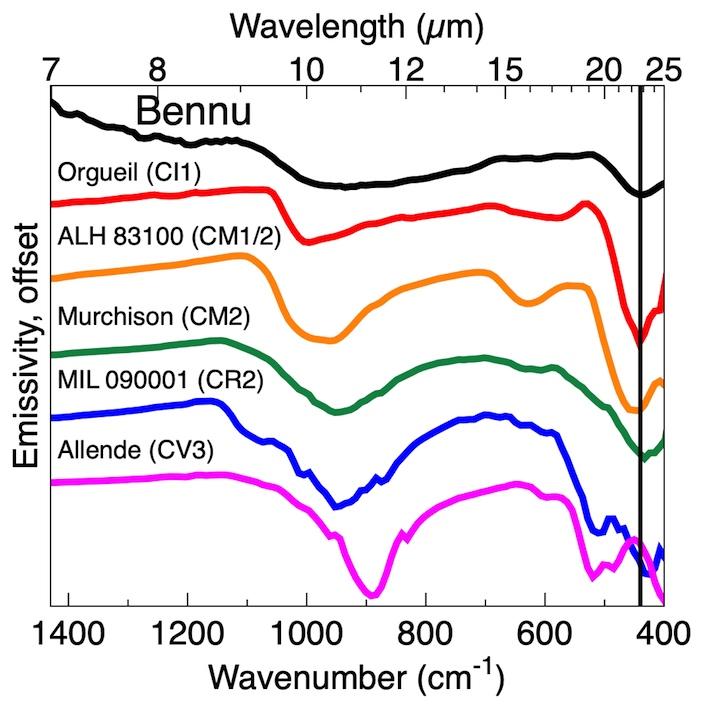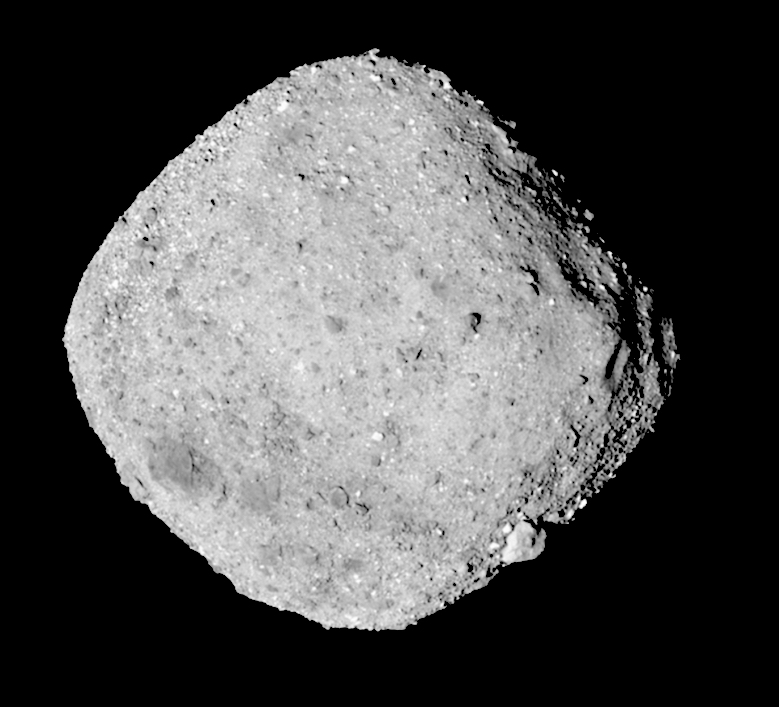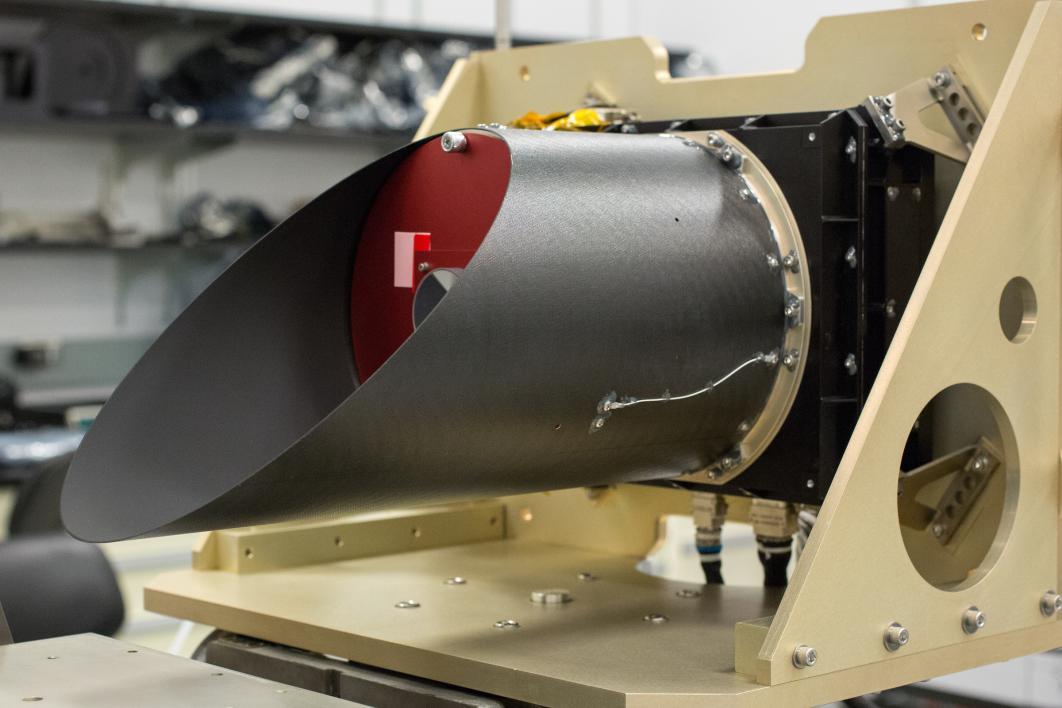ASU instrument on NASA probe finds hydrated minerals on asteroid Bennu

This artist's concept shows the OSIRIS-REx spacecraft contacting the asteroid Bennu with its Touch-And-Go Sample Arm Mechanism, or TAGSAM. The OSIRIS-REx Thermal Emission Spectrometer, built at ASU, will help scientists choose a location for TAGSAM to collect a sample for return to Earth. The spectrometer will also gather detailed information about Bennu's mineralogy and provide data to analyze the asteroid's future trajectory. Image by NASA Goddard Space Flight Center
NASA's OSIRIS-REx spacecraft, newly arrived at asteroid Bennu, has found strong spectral evidence that the asteroid's rocks have undergone interactions with water at some point in their history.
The evidence comes from two onboard spectrometers, one of them designed and built at Arizona State University's School of Earth and Space Exploration.
The discovery was announced Dec. 10 at a news conference at the American Geophysical Union's Fall Meeting in Washington, D.C.
"We're delighted to share in this discovery," said Philip Christensen, Regents' Professor in the School of Earth and Space Exploration. Christensen is the instrument scientist and designer of the OSIRIS-REx Thermal Emission Spectrometer, or OTES for short.
"The two instruments found similar results, and their data complement each other," Christensen said. "This result is just the beginning."
"Spectral interpretation of asteroids like Bennu is one of the key science objectives of OSIRIS-REx," said the University of Arizona's Dante Lauretta, principal investigator for the OSIRIS-REx mission.
"We are the first planetary mission to fly both a visible-near-infrared spectrometer and a thermal emission spectrometer. With this discovery, our investment in top-notch scientific instruments has paid off. We are confident in achieving mission success by returning pristine samples of carbonaceous asteroidal material to Earth."
Long journey
Launched in September 2016, OSIRIS-REx stands for Origins, Spectral Interpretation, Resource Identification, Security-Regolith Explorer. Led by the University of Arizona in Tucson, the mission's goal is to bring to Earth a sample of Bennu's surface materials for scientists to study. OSIRIS-REx finally arrived at Bennu on Dec. 3, 2018.
But before choosing a location to sample, the spacecraft has begun a global study of Bennu, which is about 500 meters (1,600 feet) in diameter and has a day lasting 4 hours 17 minutes. The global study, to which OTES will contribute a mineralogical survey and temperature measurements, will see the spacecraft map Bennu's entire surface at medium resolution and selected areas at high resolution.
Bennu's gravity is extremely weak: only 1/100,000th that of Earth. This means the spacecraft must move slowly, adjusting its path with small thruster burns. The global survey is expected to take until summer 2019 to complete.
When the time comes to collect a sample, OSIRIS-REx won't even land. Instead it will use a touch-and-go mechanism that jets nitrogen gas to stir up dust, sand and rock particles, plus a collector similar to a car air filter to catch the samples. The mission aims to collect at least 60 grams. The samples will then be packed away in a heat-shield-protected sample return capsule.
OSIRIS-REX will continue to study Bennu until the spacecraft leaves the asteroid in March 2021. The sample capsule will be delivered to Earth in September 2023.
Hunting paydirt
The OTES spectrometer operates at far infrared wavelengths, where rocks and surface materials reveal their mineralogical nature more clearly than at the visible wavelengths to which human eyes are sensitive.
"It's very exciting to see the first up-close thermal infrared spectra of an asteroid," said Vicky Hamilton, OTES deputy instrument scientist. Currently at the Southwest Research Institute in Boulder, Colorado, Hamilton received her PhD from ASU.
"Currently, we're seeing lots of surface in the field of view," she explained. "But when we get down closer, we'll see details and variations that are all merged together at our present distance."
The other spectrometer on the mission, the OSIRIS-REx Visible and InfraRed Spectrometer (OVIRS), made a parallel discovery using the visible and shorter infrared wavelengths where it is most sensitive.
"The presence of hydrated minerals across the asteroid confirms that Bennu, a remnant from early in the formation of the solar system, is an excellent specimen for the OSIRIS-REx mission to study the composition of primitive volatiles and organics," said OVIRS deputy instrument scientist Amy Simon, of NASA's Goddard Space Flight Center.
Watch the temperature
Working in the thermal infrared, OTES also acts as a thermometer, taking the temperature of Bennu's surface.
"Bennu is a black object at about Earth's distance from the sun," Christensen explained. "This means it gets quite hot — at noon the surface has a temperature of about 150 degrees Fahrenheit."
But because Bennu lacks an atmosphere, he says, the surface cools off quickly at night, dropping to about -45 degrees Fahrenheit just before sunrise.
Later on, when OSIRIS-REx approaches Bennu more closely, OTES will see smaller details on the asteroid. At that point, said Christensen, "The day-night temperature differences from place to place will tell us something about the physical properties of the surface materials — how loose or compacted they are."
Looking ahead, the OTES team is hoping to study boulders and other features on Bennu, which the instrument can't yet resolve.
"We have a long ways to go, but the data are very encouraging," Christensen said. "From the very first observations, we're able to talk about comparing Bennu to meteorites that people have been studying for decades.
"We're excited and looking forward to helping OSIRIS-REx find a good location to sample."
More Science and technology

ASU-led space telescope is ready to fly
The Star Planet Activity Research CubeSat, or SPARCS, a small space telescope that will monitor the flares and sunspot activity…

ASU at the heart of the state's revitalized microelectronics industry
A stronger local economy, more reliable technology, and a future where our computers and devices do the impossible: that’s the…

Breakthrough copper alloy achieves unprecedented high-temperature performance
A team of researchers from Arizona State University, the U.S. Army Research Laboratory, Lehigh University and Louisiana State…




